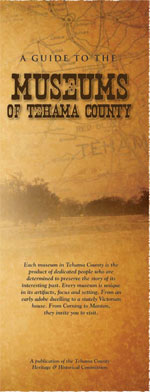History
Red Bluff derives its name from its location on a high vertical bank at the bend of the Sacramento River. Although never a mining camp, Red Bluff ranks with the celebrated towns of the gold rush days in age, exciting history, colorful personalities, and in present day importance.
The story of Red Bluff really begins seven or eight years before the community came into existence because there is a prologue covering comings and goings and projects of the famous Peter Lassen whose name was given to a county, a national park, a volcano, and a highway. At the very beginning, Red Bluff became the marketing and distributing center for a large area and its scope in that role widened steadily. By 1853 it was the chief commercial city in the northern part of the Sacramento Valley, and its streets continually thronged with pack trains operating to and from points as far away as Oregon, Nevada and Idaho.
In 1843, Lassen and two fellow pioneers were in Red Bluff tracking down horse thieves. He was so impressed by the land that he sought and received from the Mexican Government a grant of 25,000 acres, a few miles south of where the city now stands. On that tract in early 1847, he laid out a townsite and named it Benton City in honor of Senator Thomas H. Benton of Missouri. Then he journeyed to Missouri to induce settlers to come out and also to obtain a charter for a Masonic Lodge which he wished to establish in his settlement.
Lassen returned to his townsite in the summer of 1849 with a party of settlers and with the Masonic Charter. On reaching California, the members of the party learned about the discovery of gold, gave up their original idea, and headed or the mining area. So the townsite died suddenly and as a result, the lodge charter was transferred to Shasta. However, the publicity given to Lassen’s colonization plan attracted many others to the territory, including several who helped found and build Red Bluff.
Red Bluff achieved and retained commercial importance because, for more than a century, it was the head of navigation on the Sacramento River. The initial attempt at river shipping in the area was made by Lassen in 1849 when he was still to put over Benton City. But the last trip was a losing venture and he abandoned the plan. The following year steamers commenced regular and frequent trips between San Francisco and Red Bluff and soon arrivals and departures were almost a daily occurrence. The service continued until after the turn of the century.
Another noble pioneer of Red Bluff was William B. Ide, commander of the group of Americans who, in the summer of 1846, revolted against Mexican rule, seized control of Sonoma, raised the Bear Flag and proclaimed the Republic of California. Ide was “President of the Republic” from June 10 to July 8, 1846, when couriers brought word that two days previously Commodore John Drake Sloat had taken over California in the name of the United States. Ide’s home on the river bank about two miles north of Red Bluff in now under the State Park System.
Where Tehama County got its present name remains a mystery, but it was generally considered to be of Indian origin. Its interpretation is muddled and there are four choices offered: “Highland,” “Lowland,” “Shallow,” and “Salmon.”
All of the names are appropriate, for this is a land of variation. To the east and west the land begins to roll into foothills and then rears suddenly into mountain ranges. A “Tehaman” looks north to snow-capped Mount Shasta and east to Mount Lassen.
Tehama County truly is a land of opportunity and contrasting beauty!




